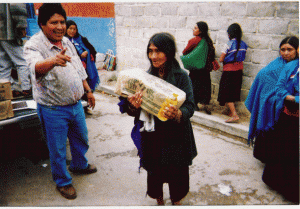 Between 1988 and 1998, my wife, children and I worked and lived outside of Mexico City. During our work with the National Presbyterian Church of Mexico, I became aware of the religious intolerance in the southern state of Chiapas. I traveled to Chiapas to observe the conditions myself, and to meet with pastor and lawyer Abdías Tovilla Jaime. He is director, legal consultant and founder of CEDECH, the State Committee of Chiapas for Evangelical Defense, located in the city of San Cristóbal de Las Casas, Mexico.
Between 1988 and 1998, my wife, children and I worked and lived outside of Mexico City. During our work with the National Presbyterian Church of Mexico, I became aware of the religious intolerance in the southern state of Chiapas. I traveled to Chiapas to observe the conditions myself, and to meet with pastor and lawyer Abdías Tovilla Jaime. He is director, legal consultant and founder of CEDECH, the State Committee of Chiapas for Evangelical Defense, located in the city of San Cristóbal de Las Casas, Mexico.
Tovilla began this ministry as a volunteer in 1981, in response to the needs of persecuted believers. “Christian brothers arrived (in San Cristóbal) who’d been beaten,” he recalls. “They’d say, ‘Pastor, help us;’ so I had to do something, even though how to defend human rights was not something I learned in seminary.” In 1992, the National Presbyterian Church of Mexico made CEDECH one of its official ministries, with the slogan “For an integral, Christian liberty” (“Por una libertad cristiana integral”).
As a result of this experience, my three-part series exposing the religious persecution against Presbyterians in Chiapas was first published by World Pulse in 1998. This series, including photographs, was subsequently reprinted in Indian Life, an international newspaper based in Winnipeg, Manitoba.
In turn, this series – along with my articles that preceded it – formed the foundation for my journalistic novel, Once: Once (Spanish for “11:11”). Indian Life, the Canadian publication that reprinted my series, said of my book: “Like a story lifted off the page of today’s newspaper.”
My first article on the troubling situation in Chiapas appeared in January, 1994, where I reported two recent events in which approximately 350 evangelical Christians of the Tzotzil ethnic group “were brutally beaten, put in jail and expelled from their communities of origin, taking away all their belongings and burning some of the houses,” quoting one Mexican leader. All this occurred in spite of a new religious freedom law, adopted in 1992, which ostensibly guaranteed that each individual shall “not be the object of discrimination, compulsion or hostility as a result of his religious beliefs.”
My second article about this issue appeared on May 5, 1995, where I pointed out that “Mexico’s preoccupation with the Zapatista guerrilla army, both by politicians and the media, has overshadowed the other side of the Chiapas crisis: the 20,000 to 30,000 believers in Chiapas exiled ‘for professing the Protestant religion.’ ”
As a result of the persecution in the Chiapas highlands, several refugee settlements have sprung up around the city of San Cristóbal de Las Casas. I acquired firsthand experience by traveling to both San Cristóbal de Las Casas and Tuxtla Gutiérrez, Chiapas, where I conducted on-site investigation and interviews, including a trip to San Juan Chamula, the renowned “headquarters” of such persecution. Following this on-site investigation, my three-part series exposing the religious persecution in Chiapas was published in World Pulse.
To read the complete text of all five of my articles that were published concerning the situation in Chiapas, click on this link:
http://www.leecuestabooks.com/chiapas/
and then click on the article titles.
